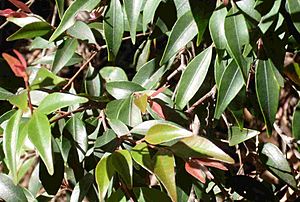Peach myrtle facts for kids
Quick facts for kids Peach myrtle |
|
|---|---|
 |
|
| Conservation status | |
| Scientific classification | |
| Genus: |
Uromyrtus
|
| Species: |
australis
|
The peach myrtle, also known as Uromyrtus australis, is a beautiful small tree found in New South Wales, Australia. It mostly grows in the Nightcap National Park area. This special tree is currently endangered, meaning it's at risk of disappearing forever. Its pretty pink flowers, delicate leaves, and tasty fruit make it a truly unique plant.
Where the Peach Myrtle Lives
The peach myrtle only grows in a small area. It loves places with lots of rain, especially in warm rainforests. You can find it high up in the mountains, usually between 400 and 770 metres (about 1,300 to 2,500 feet) above sea level. Sadly, there are only about 800 peach myrtle trees left in the wild.
What the Peach Myrtle Looks Like
The peach myrtle can grow up to 12 metres (about 40 feet) tall. Its trunk can be about 15 centimetres (6 inches) wide. The bark is brown and often looks flaky or scaly.
Its leaves grow in pairs, one opposite the other. They are usually 2.5 to 4.5 centimetres (1 to 1.8 inches) long and have a pointed tip. The top of the leaves is shiny, while the bottom is dull. When new leaves grow, they are bright red and have soft white hairs. As the leaves get older, they become smooth.
Flowers and Fruit
In November and December, the peach myrtle blooms with white flowers that later turn a lovely deep pink color. After the flowers, the tree produces small, round black berries. These berries are about 5 to 8 millimetres (0.2 to 0.3 inches) wide. Each berry has one or two sections, and each section holds two seeds. The fruit is ready to eat from April to July. If you remove the outer layer of the seed, they can start growing into new plants in about two months.
See also
 In Spanish: Uromyrtus australis para niños
In Spanish: Uromyrtus australis para niños



